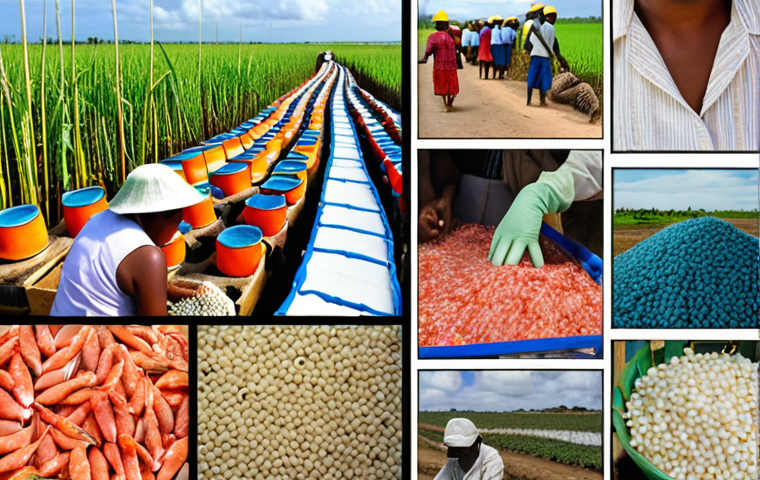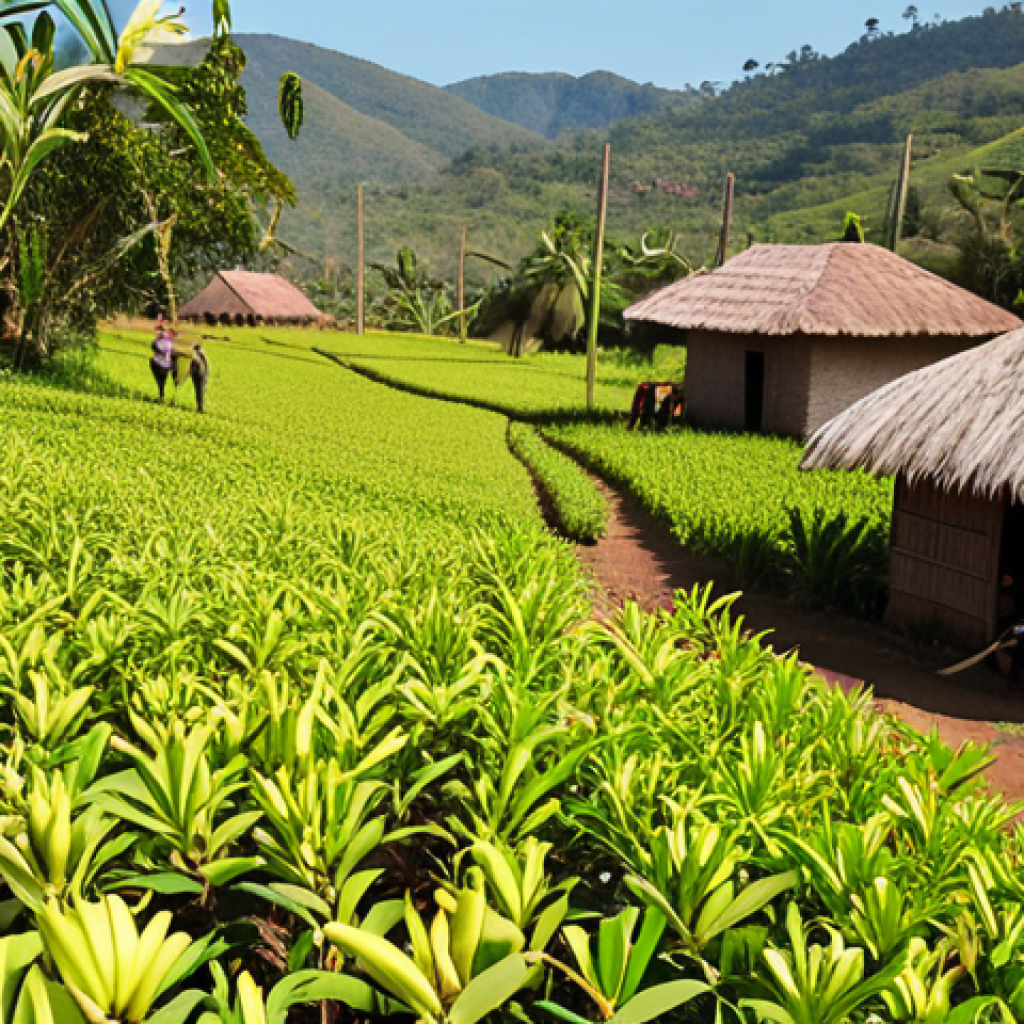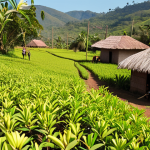Madagascar, the island nation famed for its unique biodiversity, relies heavily on exports to fuel its economy. While vanilla often steals the spotlight, Madagascar’s export basket is surprisingly diverse.
From precious minerals to agricultural products, and even textiles, the island’s economy is intertwined with global markets. I’ve always been curious about what exactly gets shipped off those shores and where it all ends up, a question that I know I’m not alone in asking!
Understanding Madagascar’s major exports isn’t just about economics; it’s about understanding the livelihoods of its people. So, let’s dive deeper and explore the key commodities that shape Madagascar’s trade landscape.
Let’s unravel the details below!
The Reign of Vanilla: More Than Just Flavor

The Allure of Madagascar Vanilla
Madagascar’s vanilla isn’t just any vanilla; it’s the real deal. I remember once trying to bake a cake with imitation vanilla extract, and it was a total disaster.
The flavor was artificial and overpowering. Then, a friend who’d traveled to Madagascar brought me some real vanilla beans. The difference was night and day.
The aroma alone was intoxicating – rich, creamy, and intensely sweet. The resulting cake was a masterpiece, and I’ve been a Madagascar vanilla convert ever since.
This vanilla accounts for a significant portion of the world’s supply, making it a critical economic driver. The unique climate and soil conditions create the perfect environment for cultivating this prized spice.
The process is incredibly labor-intensive, involving hand-pollination and careful curing, which adds to its value and reputation.
Beyond the Bean: Vanilla’s Ripple Effect
But the vanilla trade isn’t without its complexities. The fluctuating prices can be a rollercoaster for farmers, and stories abound of vanilla theft, as the green pods are far from worthless even before curing.
I once read an article about how entire communities in Madagascar are affected by the vanilla harvest season, with families relying on the income to send their kids to school and improve their homes.
When prices are high, it’s a boon. But when prices crash, it can be devastating. The vanilla trade has a massive ripple effect across Malagasy society, impacting everything from education to infrastructure.
Gemstones and Minerals: Madagascar’s Hidden Treasures
A Sparkle in the Rough: Sapphire and Ruby
Madagascar is not only a land of lush rainforests and unique wildlife but also a treasure trove of gemstones. Sapphires, rubies, and emeralds are among the many precious stones that are mined and exported.
I was amazed to learn that some of the world’s finest sapphires come from Madagascar. These gemstones are often found in alluvial deposits, requiring intensive manual labor to extract.
I watched a documentary once that followed the lives of artisanal miners in Madagascar. The miners work in incredibly harsh conditions, digging and sifting through tons of earth in the hopes of striking it rich.
It’s a tough life, but the lure of finding a valuable gemstone keeps them going.
More Than Just Pretty Rocks: Ilmenite and Chromite
Beyond the glamorous world of gemstones, Madagascar also exports industrial minerals like ilmenite and chromite. These minerals are essential components in the production of various goods, from paints and plastics to stainless steel.
I remember reading about a large-scale mining project in Madagascar that aimed to extract ilmenite. While the project promised to bring economic benefits to the region, it also raised concerns about environmental impacts, such as deforestation and water pollution.
It’s a complex balancing act between economic development and environmental protection.
Clothing and Textiles: Stitching Together an Economy
From Cotton Fields to Global Fashion: The Textile Industry
Madagascar’s textile industry has seen its ups and downs. The country produces garments for international brands, taking advantage of preferential trade agreements.
I have a friend who works in the fashion industry, and she explained to me how many of the clothes we wear are made in countries like Madagascar, where labor costs are lower.
The textile industry can provide jobs for many Malagasy people, especially women, but it also faces challenges related to competition from other low-cost producers.
Navigating the Global Market: Challenges and Opportunities
To remain competitive, Madagascar’s textile sector must focus on quality, innovation, and sustainability. I’ve noticed a growing trend among consumers who are looking for ethically produced clothing.
If Madagascar can position itself as a source of high-quality, ethically made garments, it could attract more buyers and boost its exports.
Seafood: Casting a Wide Net
The Bounty of the Indian Ocean: Shrimp and Fish
As an island nation, Madagascar naturally relies on its marine resources. Shrimp and fish are important exports, contributing to the livelihoods of coastal communities.
I’ve heard stories about the incredible diversity of marine life around Madagascar, with colorful coral reefs and abundant fish stocks. Sustainable fishing practices are crucial to ensure that these resources are available for future generations.
Sustaining the Seas: Challenges in Fisheries Management
Overfishing and illegal fishing can deplete fish stocks and damage marine ecosystems. I read about efforts to promote sustainable fisheries management in Madagascar, involving community-based conservation initiatives and stricter enforcement of regulations.
Protecting the marine environment is not only vital for the economy but also for the well-being of the Malagasy people.
Coffee and Spices: Aromatic Delights
Beyond Vanilla: Coffee’s Rich Brew
While vanilla is king, Madagascar also produces coffee and other spices like cloves and pepper. These products add diversity to the export portfolio and support numerous smallholder farmers.
I once tried a cup of Madagascar coffee, and it had a unique, slightly floral aroma. It was a welcome change from the more common robust blends.
The Spice of Life: Diversifying Agriculture
Diversifying agricultural exports can help Madagascar reduce its reliance on vanilla and mitigate the risks associated with price volatility. Supporting farmers in adopting sustainable farming practices is also essential for long-term success.
I think it’s important to remember that behind every exported product is a farmer who is working hard to provide for their family.
Essential Oils: Bottling Nature’s Essence
Fragrant Exports: Ylang-Ylang and More
Madagascar is becoming known for its essential oils, particularly ylang-ylang, which is used in perfumes and aromatherapy. The fragrant flowers are harvested and processed to extract the oil, which has a distinctive floral scent.
I once visited a distillery that produced essential oils, and it was fascinating to see the process firsthand. The air was filled with the most amazing aromas.
Tapping into the Global Wellness Market
The global market for essential oils is growing, driven by increasing interest in natural health and wellness products. Madagascar has the potential to expand its essential oil exports by focusing on quality and sustainable production practices.
Consumers are increasingly looking for products that are not only effective but also environmentally friendly.
Sugar: Sweetening the Deal
From Cane Fields to Global Markets: Madagascar’s Sugar Industry
Sugar is another significant export commodity for Madagascar, with sugarcane plantations dotting the landscape. The sugar industry provides employment opportunities and contributes to the country’s foreign exchange earnings.
However, the industry also faces challenges related to competition from other sugar-producing nations and fluctuating global prices.
Balancing Production and Sustainability
Sustainable sugarcane farming practices are essential to minimize the environmental impact of sugar production. This includes efficient water management, reduced use of pesticides, and soil conservation measures.
By adopting these practices, Madagascar can ensure the long-term viability of its sugar industry.
| Export Commodity | Description | Key Markets |
|---|---|---|
| Vanilla | The most famous export, used in flavoring food and beverages. | United States, Europe |
| Gemstones | Sapphires, rubies, and other precious stones. | Thailand, Switzerland |
| Clothing and Textiles | Garments produced for international brands. | Europe, United States |
| Seafood | Shrimp, fish, and other marine products. | Japan, Europe |
| Coffee | Arabica and Robusta varieties. | Europe, United States |
| Essential Oils | Ylang-ylang, clove oil, and other fragrant oils. | Europe, United States |
| Sugar | Raw and refined sugar. | Regional African markets, Europe |
The Future of Madagascar’s Exports
Diversification is Key
Looking ahead, Madagascar needs to diversify its export base to reduce its vulnerability to fluctuations in commodity prices. Investing in value-added industries, such as processing agricultural products and manufacturing finished goods, can create new opportunities and boost economic growth.
Sustainable Development
Sustainable development is also crucial for ensuring that Madagascar’s exports benefit all Malagasy people. This includes protecting the environment, promoting fair labor practices, and investing in education and healthcare.
By prioritizing sustainability, Madagascar can build a more resilient and prosperous economy for the future. It’s about ensuring that economic growth doesn’t come at the expense of the environment or the well-being of its people.
It’s a long-term vision for a better Madagascar.
In Conclusion
Madagascar’s export economy is a vibrant mix of unique treasures and essential commodities. From the coveted vanilla beans that flavor our desserts to the gemstones that adorn our jewelry, each export tells a story of hard work, natural beauty, and global connection. By embracing diversification and prioritizing sustainability, Madagascar can secure a prosperous future for its people and its economy.
Good to Know Information
1. Currency: The Malagasy Ariary (MGA) is the official currency. While credit cards are accepted in larger cities, cash is essential in rural areas.
2. Language: The official languages are Malagasy and French. While French is widely spoken, learning a few basic Malagasy phrases can greatly enhance your travel experience.
3. Tipping: Tipping is not mandatory but is appreciated for good service. A 10% tip is customary in restaurants and for tour guides.
4. Bargaining: Bargaining is common in markets and with street vendors. Be respectful and friendly during negotiations.
5. Visa Requirements: Check the latest visa requirements before traveling to Madagascar. Many nationalities can obtain a visa on arrival, but it’s always best to confirm in advance.
Key Takeaways
Madagascar’s economy relies on a diverse range of exports, including vanilla, gemstones, textiles, seafood, coffee, essential oils, and sugar.
Vanilla, especially from Madagascar, is highly prized for its exceptional flavor and aroma.
The vanilla trade has a significant impact on the livelihoods of Malagasy communities.
Madagascar is a source of high-quality sapphires and other gemstones.
Sustainable fishing practices are essential for preserving Madagascar’s marine resources.
Essential oils like ylang-ylang are becoming increasingly important exports.
Diversification and sustainable development are key to Madagascar’s economic future.
Frequently Asked Questions (FAQ) 📖
Q: Besides vanilla, what are some other significant exports from Madagascar?
A: Well, from what I’ve gathered digging around, Madagascar’s export scene is more than just vanilla. Sure, it’s a big player, but they also ship out precious minerals like ilmenite and chromite, which are crucial for making all sorts of things, from alloys to pigments.
Plus, they’ve got agricultural products like cloves, coffee, and seafood that find their way onto tables around the world. Textiles are in the mix, too!
It’s a diverse bunch, reflecting the island’s rich resources.
Q: Where do Madagascar’s exports typically go? Which countries are their biggest trade partners?
A: That’s a great question! From my understanding, Madagascar’s exports head to various corners of the globe, but Europe, particularly France, has historically been a major trading partner.
They also trade quite a bit with the United States and increasingly with Asian countries like China. It really depends on the specific commodity, but those are some of the key destinations I’ve come across in my research.
It’s all about finding the best markets for what they’ve got, you know?
Q: How does Madagascar’s export economy affect the lives of ordinary Malagasy people?
A: From what I’ve read, the export economy is deeply connected to the livelihoods of many Malagasy people. Agriculture, mining, and textile production provide jobs and income for a significant portion of the population.
When exports are strong, it can lead to economic growth and improved living standards. However, reliance on exports can also make the economy vulnerable to fluctuations in global commodity prices.
Also, there’s a big focus on sustainable practices, since so many families depend on these products and Madagascar takes the preservation of their unique environment very seriously.
I mean, imagine depending on a single crop and its price suddenly crashing – that’s a real concern for many families there.
📚 References
Wikipedia Encyclopedia
구글 검색 결과
구글 검색 결과
구글 검색 결과
구글 검색 결과
구글 검색 결과

